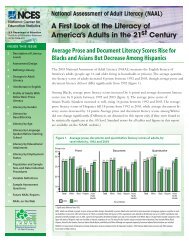Adult Literacy in America - National Center for Education Statistics ...
Adult Literacy in America - National Center for Education Statistics ...
Adult Literacy in America - National Center for Education Statistics ...
You also want an ePaper? Increase the reach of your titles
YUMPU automatically turns print PDFs into web optimized ePapers that Google loves.
levels almost every time. When the bar is higher than their level of proficiency,<br />
however, they can be expected to have a much lower chance of clear<strong>in</strong>g it<br />
successfully.<br />
Once the literacy tasks are placed on their respective scales, us<strong>in</strong>g the<br />
criterion described here, it is possible to see how well the <strong>in</strong>teractions among<br />
the task characteristics expla<strong>in</strong> the placement of various tasks along the scales. 1<br />
In <strong>in</strong>vestigat<strong>in</strong>g the progression of task characteristics across the scales, certa<strong>in</strong><br />
questions are of <strong>in</strong>terest. Do tasks with similar difficulty values (that is, with<br />
difficulty values near one another on a scale) have certa<strong>in</strong> shared<br />
characteristics? Do these characteristics differ <strong>in</strong> systematic ways from tasks <strong>in</strong><br />
either higher or lower levels of difficulty? Analyses of the <strong>in</strong>teractions between<br />
the materials read and the tasks based on these materials reveal that an ordered<br />
set of <strong>in</strong><strong>for</strong>mation-process<strong>in</strong>g skills appears to be called <strong>in</strong>to play to per<strong>for</strong>m<br />
the range of tasks along each scale.<br />
To capture this order<strong>in</strong>g, each scale was divided <strong>in</strong>to five levels that reflect<br />
the progression of <strong>in</strong><strong>for</strong>mation-process<strong>in</strong>g skills and strategies: Level 1 (0 to<br />
225), Level 2 (226 to 275), Level 3 (276 to 325), Level 4 (326 to 375), and<br />
Level 5 (376 to 500). These levels were determ<strong>in</strong>ed not as a result of any<br />
statistical property of the scales, but rather as a result of shifts <strong>in</strong> the skills and<br />
strategies required to succeed on various tasks along the scales, from simple to<br />
complex.<br />
The rema<strong>in</strong><strong>in</strong>g pages of this section describe each scale <strong>in</strong> terms of the<br />
nature of the task demands at each of the five levels. After a brief <strong>in</strong>troduction<br />
to each scale, sample tasks <strong>in</strong> each level are presented and the factors<br />
contribut<strong>in</strong>g to their difficulty are discussed. The aim of these discussions is to<br />
give mean<strong>in</strong>g to the scales and to facilitate <strong>in</strong>terpretation of the results<br />
provided <strong>in</strong> the first and second sections of this report.<br />
Interpret<strong>in</strong>g the <strong>Literacy</strong> Levels<br />
Prose <strong>Literacy</strong><br />
The ability to understand and use <strong>in</strong><strong>for</strong>mation conta<strong>in</strong>ed <strong>in</strong> various k<strong>in</strong>ds of<br />
textual material is an important aspect of literacy. Most of the prose materials<br />
adm<strong>in</strong>istered <strong>in</strong> this assessment were expository — that is, they <strong>in</strong><strong>for</strong>m, def<strong>in</strong>e,<br />
or describe — s<strong>in</strong>ce these constitute much of the prose that adults read. Some<br />
narrative texts and poems were <strong>in</strong>cluded, as well. The prose materials were<br />
drawn from newspapers, magaz<strong>in</strong>es, books, brochures, and pamphlets and<br />
repr<strong>in</strong>ted <strong>in</strong> their entirety, us<strong>in</strong>g the typography and layout of the orig<strong>in</strong>al<br />
source. As a result, the materials vary widely <strong>in</strong> length, density of <strong>in</strong><strong>for</strong>mation,<br />
1 I.S. Kirsch and P.B. Mosenthal. (1990). “Explor<strong>in</strong>g Document <strong>Literacy</strong>: Variables Underly<strong>in</strong>g the<br />
Per<strong>for</strong>mance of Young <strong>Adult</strong>s.” Read<strong>in</strong>g Research Quarterly, 25. pp. 5-30.<br />
Section III ......73



